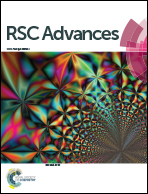Synthesis of a copper(ii) complex covalently anchoring a (2-iminomethyl)phenol moiety supported on HAp-encapsulated-α-Fe2O3 as an inorganic–organic hybrid magnetic nanocatalyst for the synthesis of primary and secondary amides
Abstract
A novel hydroxyapatite-encapsulated-α-Fe2O3-based Cu(II) organic–inorganic hybrid (interphase) catalyst was prepared. The prepared nanocatalyst provided an efficient, useful and green method for the oxidative amidation of aromatic aldehydes with ammonium hydrochloride and aniline hydrochloride, in short reaction times and good yields. The magnetic nature of the catalyst led to its easy recovery by an external magnetic field and convenient reuse.


 Please wait while we load your content...
Please wait while we load your content...